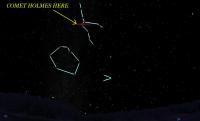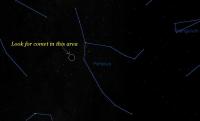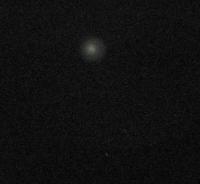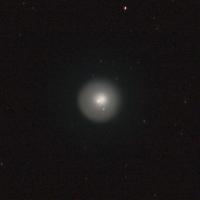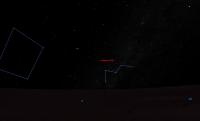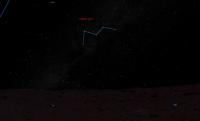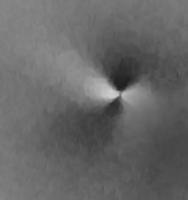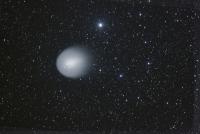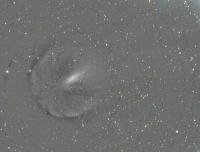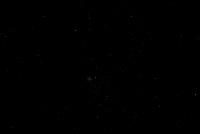Printable Version of Topic
Click here to view this topic in its original format
Unmanned Spaceflight.com _ Cometary and Asteroid Missions _ Huge comet outburst reported
Posted by: Elias Oct 24 2007, 02:11 PM
I didnt know in which category of the forum this should be reported:
http://www.fototime.com/%7BE39A64F6-CE74-412E-A4B2-32C0A71BE01E%7D/picture.JPG
http://perso.orange.fr/fkometes/images/comets_img/17P-07102422-9x5sz05.JPG
Comet 17p/Holmes from 15 mag to 3!! ![]()
Already visible to naked eye!
Posted by: jamescanvin Oct 24 2007, 02:37 PM
Thanks for the heads up.
More information, inc finding chart http://www.aerith.net/comet/catalog/0017P/2007.html.
Now if only these dam clouds would lift.
J
Posted by: Ames Oct 24 2007, 02:41 PM
Wow he is correct. Magnitude graph and finder chart http://www.aerith.net/comet/catalog/0017P/2007.html.
Posted by: ugordan Oct 24 2007, 02:51 PM
Wow. What's the probability we witnessed this baby breaking up?
Posted by: ngunn Oct 24 2007, 03:03 PM
Thanks, folks! I'll be out looking in a few hours.
Posted by: stevesliva Oct 24 2007, 03:28 PM
Sounds like it was discovered during/after a big outburst... but that the perihelion has been increasing since then.
http://cometography.com/pcomets/017p.html
Posted by: Stu Oct 24 2007, 03:40 PM
Here's where to look folks...
(position plotted on Starry Night Pro, blame them if it's wrong!
Posted by: djellison Oct 24 2007, 05:00 PM
Thank god I got my 15x70's off my boss who 'borrowed' them for about a month ![]()
Doug
Posted by: Stu Oct 24 2007, 05:02 PM
This is the latest from the British Astronomical Association...
-----------------------------------------------------------------------------------
In the past 24 hours, a spectacular event has taken place involving the periodic comet P/Holmes (17P). Its predicted brightness is about magnitude 17 however last night it was discovered by the Spanish amateur, Juan Antonio Henríquez Santana to have undergone a tremendous outburst having attained magnitude 10 at that time (Oct 24 0h UT). It was a similar outburst in 1892 that led to its discovery.
Latest reports (Seiichi Yoshida, Oct 24 13h UT) indicate that it is stellar in appearance and 3RD MAGNITUDE in brightness: so bright in fact that it is readily visible to the unaided eye. That's almost one million times brighter than normal !
Fortunately for UK-based observers the comet is well placed for observation and is visible throughout the entire night. Its position at 0h UT tonight (Oct 24/25) will be:
R.A. 03h 53.0m, Dec. +50 08'
Its appearance will probably be that of a fairly bright naked-eye star moving at an apparent rate of close to 10 arcmin per day at PA 298 deg. It is currently 1.63 AU (245 million km) from the Earth.
-------------------------------------------------------------------------------------------------------
Of course, after 3 gorgeously clear nights here in Kendal it's totally (chink) overcast tonight...
Posted by: Marz Oct 24 2007, 05:09 PM
Zoiks! If Holmes exploded, is there going to be a cone of cometlets coming to visit in 2014?
I'll have to look for it tonight. I hope it's not fading already.
Posted by: akuo Oct 24 2007, 06:20 PM
Thanks guys. I'm a keen comet observer and this was the first I saw of this news. Too bad it looks like it will be cloudy for the whole night here.
Posted by: dvandorn Oct 24 2007, 06:27 PM
And my guess here is that it won't be visible to observers in the Western Hemisphere... *sigh*...
-the other Doug
Posted by: Stu Oct 24 2007, 06:42 PM
Hey oDoug,
It will be just as visible from Minneapolis as from where I am ![]() The finder charts I posted are fine for your part of the world too. As long as you can see perseus you can look for the comet.
The finder charts I posted are fine for your part of the world too. As long as you can see perseus you can look for the comet. ![]()
Posted by: Paolo Oct 24 2007, 06:55 PM
The same in Milan!
Posted by: akuo Oct 24 2007, 07:39 PM
The comet is well placed for anyone in mid-northern latitudes and northward. Perseus is quite high already when it gets dark, and it gets higher in the sky during the night. All you need is some clear weather. For the rest of the northern hemisphere its still visible.
Seiichi Yoshida now reports that the comet has stabilised at 2.8 mag. This would make it look like a bright new star in Perseus (its reported to be stellar in appearance).
Posted by: stevesliva Oct 24 2007, 08:24 PM
Spaceweather has started coverage... nice photo of exactly where it is.
http://spaceweather.com/archive.php?view=1&day=24&month=10&year=2007
Posted by: ngunn Oct 24 2007, 08:50 PM
I went out for a look about an hour ago. Slight haze and lots of moonlight so I used binoculars. I found a 'star' in the position indicated (using ephemeris position and Norton's Star Atlas) not a lot fainter than Delta Persei. I'd guess about magnitude 3.5. I've never seen a comet looking like a fairly bright star before so I retired indoors puzzled as clouds overtook the scene. Checked here and - well it seems that was it! I wonder how long it will remain so bright and starlike? I look forward to following its progress if weather allows.
Posted by: nprev Oct 24 2007, 11:41 PM
Pics, please, gentlemen, if you can...not only am I in LA, but the whole area's covered with smoke from these damned wildfires (cough, cough...)
Posted by: MizarKey Oct 25 2007, 07:23 AM
I just saw it a few minutes ago...WOW! What an odd duck this comet is...my very first impression: like looking down on Saturn. The nucleus is bright and orangeish and the coma is nearly pefectly round and grey like fog. I used 20X80 binoculars and I'm in central California under clear skies with a bright moon.
Locating it was easy if you know how Perseus is supposed to look...the comet stands out.
Worth a look!
Posted by: ugordan Oct 25 2007, 08:37 AM
Via SpaceWeather.com comes this one:
http://www.spaceweather.com/comets/holmes/24oct07/Eric-Allen1.jpg
It really looks like an instantaneous, symmetrical release of volatiles which are now slowly expanding to form a visible coma. The comet's brightness might stay the same (or even increase a bit) until this coma dissipates and changes the comet's appearance from a star-like object to a fuzzy, dim blob.
I can't imagine what could have triggered such an event. An impact comes to mind, but are we really expected to see such a rare event, statistically speaking?
Was it a simple case of falling apart under thermal stress?
Who needs Deep Impact when you've got this.
Posted by: ngunn Oct 25 2007, 09:17 AM
I was wondering that too. It seems to have been so sudden. Most comet break-ups are protracted, multi-staged affairs. You'd need a huge build-up of internal pressure to produce a single explosive event as this seems to have been. A collision could certainly do it. It's only a single event so maybe statistics are a poor guide. Let's hope observations can narrow down the possibilities.
Posted by: ugordan Oct 25 2007, 09:23 AM
Are there any constraints about its rotational period? I'm wondering if a fast enough rotation would homogenize the coma even with a directional outburst. An impact would probably not be symmetric unless the whole thing got blown up. We'll need some more observations to see if there's a directional component to the outgassing.
Posted by: ngunn Oct 25 2007, 09:32 AM
Interesting, but maybe that depends on whether or not the bright centre we see now actually corresponds to the position of the nucleus.
Posted by: ngunn Oct 25 2007, 10:37 AM
From the account here
http://www.ast.cam.ac.uk/~jds/per01.htm
it seems that this comet did something similar at the time of its discovery in 1892.
So probably no collision, just an unusually tough crust.
Posted by: MizarKey Oct 25 2007, 01:40 PM
http://www.spaceweather.com/comets/holmes/24oct07/Eric-Allen1.jpg
That picture is very good, but with the naked eye it appears orangeish yellow. When I first went out to look at it I was holding the binocular in my hands (20x80 binocs are pretty heavy and you get tired of holding them up quick). I first looked at the Pleiades to make sure the focus was good. At the time I had only a rough idea where the comet was (near Mirfak according to Phil Plait - the bad astronomer). When I found the comet I thought the focus had gone out and I tried refocusing...with no luck of course. Even though he had mentioned it was mag. 3 or so, I was surprised at how bright and round it was. I might even get my little telescope out of storage for this one...
Posted by: PhilCo126 Oct 25 2007, 02:35 PM
more info and pictures: http://www.aerith.net/comet/catalog/0017P/2007.html
![]()
Posted by: Holder of the Two Leashes Oct 25 2007, 03:49 PM
Stepped outside last night at local midnight and looked straight up. It took almost no time at all to see there was something "wrong " with Persues. The extra "star" was very visible and unmistakeable.
I got out my little trusty Astroscan on low magnification (16X). Took awhile to aim it, given the angle, but finally found it. Even at low magnification, there was nothing starlike about it at this point. Looked like a little bright tan blob, with a distinct core and an even, thin, circular, bright fuzzy haze around the the core . It may have been my eyes, or the telescope, or both, but I think there was a short and faint tail starting to develop.
My observations were made from Tulsa, Oklahoma in the US.
Posted by: Holder of the Two Leashes Oct 25 2007, 04:25 PM
Deep Impact is schedueled to fly by earth December 31st to be targeted to comet Beothin. I know it's a long shot, but does anyone know if it would be possible to retarget the spacecraft to Holmes instead? Just as a possible option, I'm not saying they should if they can.
Posted by: djellison Oct 25 2007, 05:07 PM
The chances of the mechanics working are near zero I would have thought. Holmes is quite far out of the ecliptic.
Meanwhile the clouds here are strengthening my belief that there is a direct correlation between the UK climate and transient astronomical phenomenon.
Doug
Posted by: Stu Oct 25 2007, 05:42 PM
Doug
Oh Doug, I think that was first proved about a decade ago when I organised half a dozen "Skywatch" nights to show people Comet Hale-Bopp and it was cloudy for every one of them...
Up here in Kendal tonight the cloud cover is thicker than Jade Goody, and I've about as much chance of seeing Holmes as I have of hearing a knock on my door and opening it to find a rain-soaked Keira Knightley standing there, shivering, asking if she can beg a towel because she's just moved in next door and has locked herself out...
Posted by: CosmicRocker Oct 26 2007, 03:36 AM
First of all, you guys in the UK have no monopoly on lousy weather correlated with astronomical phenomena. However, I am experiencing a random anomaly here. ![]()
This is really a beautiful little comet. We luckily have cloudless skies here, so I could easily identify it with my naked eyes. I could almost convince myself that if I slightly averted my eyes, it appeared as an extended object. In my 8-20x50 binos it was clearly a fuzzball, so I brought out my little 90 mm scope so I could observe it on a steady tripod. I saw no sign of a tail. The coma was circular, with the nucleus slightly off center. The color was a pretty, golden yellow. I couldn't see any of the green that some of the on-line astrophotographs show, but I was using a rather small scope. It appeared slightly brighter than delta Persei, which is a mag 3 star, so I can believe reports that experienced brightness estimators have been calling it 2.6-2.8 recently.
Posted by: nprev Oct 26 2007, 03:37 AM
Slim odds indeed, Stu, and I share your frustration...although I'm personally hoping for Raquel Welch or Connie Chung sick of the damn smoke (hey, I'm old, and not too far from Hollywood!)
Posted by: Sunspot Oct 26 2007, 02:14 PM
Yep, horribly grey and gloomy here again. ![]()
Posted by: Canopus Oct 26 2007, 03:41 PM
We're usually blessed with clear skies...but unfortunately I've lost my Astroscan's viewfinder! ![]() Have never lost anything pertaining to astronomy equipment before. Will rummage through that closet...
Have never lost anything pertaining to astronomy equipment before. Will rummage through that closet...
What a nice surprise that comet has given us.
Posted by: hendric Oct 26 2007, 03:44 PM
I got a chance to see it last night. Very obvious in Perseus, and clearly nonstellar in the 10x50. The 20x80's showed a nice round little ball, brighter towards the middle, with a clear boundary between the edge of the coma and space.
It would figure something like this would happen in the middle of the full moon!
But it was still clearly visible anyways, and this is from Austin, TX.
Posted by: Toma B Oct 26 2007, 09:02 PM
I have just saw her... ![]()
![]()
![]()
If weather is not too lousy at your places go out with pair of binoculars and look up...
It is really easy thing to find, bright as delta Persei.
So if you saw a comet before go out and see bright comet with no tail...and if you didn't wellll it's not so bad even for beginers...
If you got telescope use it...
God luck!!!
Posted by: Rob Pinnegar Oct 27 2007, 05:49 AM
I just saw it from downtown Calgary. It's easy to pick out if you know where to look.
Still very much stellar in appearance. It'll be interesting to watch it develop over the next few days.
Posted by: climber Oct 27 2007, 06:46 PM
Perfect sky ...but (too) perfect Moon. Easily visible anyway. Look HUGE with binoculars at 10X.
I'm looking forward to see how it'll look like in another week with dark skies.
Posted by: CosmicRocker Oct 28 2007, 04:51 AM
Yeah, the moon is about as large as it gets. But thankfully it is rising ever later than the comet. 17P seems to be maintaining its brightness while slowly increasing in diameter. You've got to love surprises like this. ![]()
Posted by: NMRguy Oct 28 2007, 03:33 PM
According to a short article on SpaceWeather.com, the spherical cloud is now larger than Jupiter! (In absolute terms.) Also, the apparent brightness has been estimated to be ~2.1 or nearly that of Polaris, and "to the naked eye, it is no longer a simple point of light." We've had largely unfavorable conditions here in the Netherlands, but hopefully things clear up some night soon.
http://www.spaceweather.com/
Posted by: ugordan Oct 28 2007, 04:27 PM
The 3 frame animation and comparison to Jupiter image states the gas has an approx. 2.4 km/s mean velocity. Which velocity would that be? It can't be radial because 2.4 km/s gives over 200 000 km covered in just 1 day, while Jupiter's radius is 70-ish thousand km. The math doesn't add up somewhere. A figure of say 300 m/s sounds more plausible.
Posted by: djellison Oct 28 2007, 06:01 PM
After 4 days of complete and continuous cloud coverage, the sky has totally cleared in the last 2 hours. It's not even fully dark, but it was so so obvious to the naked eye - and thru the binos - just extraordinary.
It looked - just thru binos - exactly like this - http://spaceweather.com/comets/holmes/24oct07/Eric-Allen1.jpg
Extraordinary.
Doug
Posted by: Stu Oct 28 2007, 06:24 PM
Glad SOMEONE in the UK is seeing it at last. Up here in Kendal after a day of glorious blue skies it's cloudy again and spitting (cue Peter kay voice: "Spitting! It's spitting!") with rain so it looks like I've had it tonight as well.
Not happy. Not happy at all.
Posted by: ugordan Oct 28 2007, 07:20 PM
If it makes you feel better, you're not the only one. The entire last week has been nothing but clouds and rain here as well.
Sigh.
Posted by: Stu Oct 28 2007, 07:57 PM
Just poked my head outside and I can see a slightly brighter patch of sky where the Moon must be... fingers crossed for a little later...!! ![]()
Posted by: Sunspot Oct 28 2007, 08:02 PM
The sky has finally cleared and i've just come in from observing it with my 4.5" reflector. It does look exactly like some of the pictures i've seen. A large spherical coma with a slightly brighter annulus. Star like nucleus with a brighter patch to one side.
Posted by: Stu Oct 28 2007, 08:17 PM
... and now it's cr**ping it down. Again.
(noise of fingers drumming on desktop)
Going to take up cloud-spotting if this goes on, I swear...
Posted by: NMRguy Oct 28 2007, 08:25 PM
I agree. Rough calculations for me yield velocities of ~360m/s and this number is more or less constant for the last three days (to within error).
I also searched the literature and found nothing in the range of 2.4km/s for comet emission velocities. Most were at or less than 0.5km/s and this also seems to be the norm for comet gas emissions. What still strikes me with this comet is that the expanding cloud is spherical in shape--the gas and dust seems to be moving from the source outward largely uninhibited. Perhaps naively, I might have expected a more directed emission of the volatiles.
http://www.springerlink.com/content/pj52373143830v31/ 0.5km/s
http://www.springerlink.com/content/xu04427785w124k8/ 0.4km/s
http://www.astro.umd.edu/~farnham/linear/postper.html 0.5km/s
http://adsabs.harvard.edu/abs/2005DPS....37.4301A >0.16km/s (projected velocity)
Anyway, more rain tonight...
Posted by: nprev Oct 28 2007, 08:34 PM
Nice & clear here (finally; the damn smoke is abating as the fires come under control). Gonna give it a shot tonight naked-eye from the roof of my apartment complex. Would drive out of town, but gotta work tomorrow & as anyone who's ever been in LA for any amount of time knows you can get stuck in traffic at the drop of a hat in either direction...
Posted by: ngunn Oct 28 2007, 08:47 PM
Within the last hour skies have cleared beautifully over North Wales. The comet is in full view now, and so bright that the full moonlight hardly matters. It is much bigger and fuzzier than when I saw it first and noticeably brighter too relative to the stars of Perseus. (I hope the same happens in Cumbria, Stu. Snowdonia and Cumbria often get the same weather at about the same time so keep looking out!)
Posted by: Sunspot Oct 28 2007, 08:47 PM
The Moon is VERY bright tonight and not too far off in the sky, lets hope the comet maintains it's brightness for a few more days.
Posted by: Stu Oct 28 2007, 10:00 PM
Yes!! Finally!!! The cloud cleared around 9pm and I went outside to see if I could see Perseus - and noticed right away that there was something wrong with its shape, an extra blobby "something" that isn't usually there.... Lifted the binoculars -
GOOD GRIEF!!! Someone moved the globular cluster M13 closer to Earth! It was **ridiculous**! Like a new gas giant planet had somehow appeared in the solar system. Inside for the telescope, swung it around...
Oh. My. Word.
Look at that... it filled a quarter of the eyepiece at 26x magnification, with a stellar centre and a bright core surrounded by a fainter, larger ring. I went back inside to get my girlfriend and have her take a look, and she had the same "wow..." reaction, suggesting that it looked like "a cell" or "a jellyfish".
She went back inside then, leaving me alone in the yard with my telescope and the most ridiculous comet I've ever seen. Thought I'd push my luck and try a few photos, just holding my digi camera up to the eyepiece, and this is what I got...
Not going to make the Gallery on Spaceweather.com but I'm pretty chuffed with it
Posted by: nprev Oct 28 2007, 10:24 PM
![]() Wow!!! You got that just from a cam-to-eyepiece shot??? Unreal!
Wow!!! You got that just from a cam-to-eyepiece shot??? Unreal!
Okay, that's it: gonna see this thing, this event. If I can't see it from home, will do the drive...too damn marvelous to miss!
Posted by: Stu Oct 28 2007, 10:35 PM
That was the best out of 80 or so shots; the rest ranged from "it's just there" to "where the **** did it go?!?!" ![]()
Had to really push the camera to the limit to get that pic, cos it's a v simple low tech one. Settings: 400ASA, "cloudy", "centre spot metering", and lined up the camera lens with the eyepiece by pushing the lens into half a 35mm film cannister and then placing it against the eyepiece...
The view thru the eyepiece was SO much more impressive... I'll have to try simulating it with Photoshop or something.
Posted by: Del Palmer Oct 28 2007, 11:42 PM
Well, if 17P/Holmes is that Saturn-like object near the Moon then I guess I've just observed my first comet. ![]() Mind you, I almost broke my neck slipping on the wet grass as I rushed into the house to get my binos...
Mind you, I almost broke my neck slipping on the wet grass as I rushed into the house to get my binos... ![]()
Posted by: Pertinax Oct 29 2007, 02:28 PM
It's Monday, so what better time than now for a somewhat off the wall question? ![]()
With all the (deserved) excitement over comet Holmes, I wondered (as we did here over McNaught earlier this year) if the rovers would be able to see it. My thinking is that it would likely not be as it is well above the ecliptic and the rovers are south of Mars' equator. However, I don't have my copy of Starry Night handy at all to do any tests. Can anyone help on this front? Second (and just as important), is Spirit (or either rover really) in any possition to do even very limited evening or night obs? Again, my guess would be no but I wanted to ask to be sure.
Cheers,
-- Pertinax
Posted by: Stu Oct 29 2007, 02:48 PM
Great pic um3k! Makes mine look a bit pathetic, but I'm just happy I saw it given the weather here! ![]()
Posted by: Stu Oct 29 2007, 02:54 PM
I had a quick mess about look with Starry Night to try and figure this out myself last night, and while I found that both rovers can see Comet Holmes - it appears to be in the constellation of Cassiopeia from Mars - I can't find out what magnitude it would be because obviously the outburst brightening means all the figures Starry Night generates are waaay off. However, it stands to reason that as Mars is closer to the comet than Earth, the comet should appear brighter from Mars than it does from Earth, right? And as the rovers have imaged objects like the Orion Nebula and the Magellanic Clouds, both of which are naked eye astronomical objects, they should be able to see a big naked eye comet from Mars too, right?
Would love some professional input on this...
Posted by: Stu Oct 29 2007, 03:38 PM
Spirit's view...
and Oppy's view...
Both pics show the comet's highest point in the sky.
Again, no idea of brightness, sorry.
Posted by: djellison Oct 29 2007, 03:49 PM
They would be able to see it - without a shadow of a doubt - IF it's the same shape and size as seen from Mars as it is from Earth. It's not THAT much closer when at Mars - much of the distance from Earth to the Holmes is the out-of-ecliptic distance - perhaps it's 1/3rd closer. But even at the Earth range, it would be easily visible in Navcam as a bright star, and possibly even resolved as a tiny fuzzy dot in Pancam.
However - we are far from the heady days of >850 Whrs when we did astronomy from atop Husband Hill - so it'd be quite an 'ask' in terms of power etc.
As for other spacecraft observing it - they could do - not sure if they'd want to go the effort involved though.
Doug
Posted by: ynyralmaen Oct 29 2007, 05:23 PM
On the Yahoo group comets-ml, a subscriber named perryhelion estimates it as magnitude +1.2 from Mars.
Posted by: AndyG Oct 29 2007, 08:12 PM
Should have used the Flash, Stu - and come back a few minutes later to open the shutter!
Andy
Posted by: nprev Oct 29 2007, 08:30 PM
Please be sure to warn us if anyone employs a flash powerful enough to light up Holmes; think we'd all appreciate having time enough to take cover... ![]()
Couldn't see it last night, BTW; it actually got cloudy in LA, and we have a 30% chance of rain! (This is astonishing to us old US people, because of course we know that it never rains in southern California... ![]() )
)
Posted by: ugordan Oct 29 2007, 08:38 PM
That's why he spelled Flash with a capital F
Posted by: ed_lomeli Oct 29 2007, 08:41 PM
On Wednesday and Thursday last week, at first glance, the yellow color was most striking to me. The yellow color is still there but not as intense. I've taken video on 3 days through a 4 inch refractor with a webcamera, sometimes dodging the clouds.
http://www.youtube.com/watch?v=qtw-ncS75uo
Posted by: nprev Oct 29 2007, 09:08 PM
Hey, that's neat, Ed; thank you! ![]()
Question though: Why isn't there any apparent motion relative to the stars in the field? Is this thing receding almost directly away from our line of sight (since it seems to be getting dimmer)? Not a criticism, it's just interesting...never seen a comet do that before.
Posted by: ilbasso Oct 30 2007, 02:08 AM
Glorious! Had a beautiful view of it this evening. I even persuaded my wife, who has a broken knee, to make the trek with her walker out into our driveway to see it, using my 20x80 binoculars. The comparison to M13 is apt, but this is MUCH brighter. Sky and Telescope calls this "the strangest comet to burst onto the celestial scene in our lifetime." I believe it!
Posted by: ed_lomeli Oct 30 2007, 02:45 AM
Question though: Why isn't there any apparent motion relative to the stars in the field? Is this thing receding almost directly away from our line of sight (since it seems to be getting dimmer)? Not a criticism, it's just interesting...never seen a comet do that before.
The comet reached perihelion with the Sun back in May so its distance from the Sun has been increasing while Earth will reach its closest approach to the comet (1.62 A.U.) between November 5-7th. Holmes is currently both moving away from Earth and getting closer to Earth, huh? Incidental with the timing of the comet's outburst, if I have it right, the Earth's orbit must be taking us in the same direction as the comet but at a slightly higher relative velocity thus allowing us to try to catch up until next week; after then, the comet's relative velocity will not be offset by Earth's velocity. BTW, that was 110 consecutive frames of raw video @ 2.75 sec/frame.
The dimming, a wild guess, the source of the dusty material may've ended its eruptive phase, but the expansion of the material already ejected would continue, resulting in a shell of debris, which would eventually dissipate.
Posted by: alan Oct 30 2007, 03:18 AM
I haven't taken a look at its orbit but I suspect Holmes can both recede from the sun and be getting closer to Earth if its orbit is bringing it closer to the ecliptic.
Posted by: mhoward Oct 30 2007, 03:37 AM
It's huge! I had only a rough idea where to look, and noticed it as a fuzzy star, even in the bright-sky suburbs here. Through 10x50 binoculars, it's amazing! Much bigger and brighter than I was expecting.
Posted by: ElkGroveDan Oct 30 2007, 04:56 AM
I've been putting it off, but it's a perfect night here. We had a small thunderstorm pass over and then the skies cleared.
It sure is easy to find. Face Northeast and look up with binoculars.
Just wow.
Posted by: dvandorn Oct 30 2007, 05:06 AM
Using Ed's excellent video as my reference, it looks to me like the nucleus -- the actual cometary body -- is located significantly to the upper left of the center of the apparently spherical coma around the comet.
In addition, although my eyes may be playing tricks on me, I can convince myself that I see the faintest of traces of linear features within the coma emanating from the nucleus "in" to the somewhat denser center of the coma.
I ask myself about the dynamics of such a violent eruption. I'd have to guess that such a cloud of gas and dust, which has expanded to be larger than Jupiter in physical size, would have to have quite a bit of mass entrained within it. In other words, it seems like an *awful* lot of mass shot off that comet all at once. And if the faint linear features I think I can see are really there, then the mass shot out in a pretty straight linear column, forming a center of an expanding cloud at the place where the comet *was* when the explosion occurred, not anywhere near where the comet is *now*... the energy of the release being sufficient to separate the comet from the center of the expanding cloud.
Are there models out there that allow for such an energetic release of material from a comet? Could you actually get the pressures and temperatures in the ices and dust and rocks that make up the comet for an explosion of this magnitude?
Or do we need to be thinking about impact processes, here?
Obviously, you can postulate an impactor within the Solar System both big enough and with a large enough relative speed in re the comet to have done this. Can you also postulate an endogenous process that would account for it as easily?
-the other Doug
Posted by: Stu Oct 30 2007, 05:52 AM
Just been enjoying some gorgeous views of the comet here before dawn breaks over the Lake District... it's a remarkable sight in my humble 4.5" reflector, and I'm pretty sure that the coma looked lop-sided this morning, not so much spherical as last night, more like a gibbous Moon... anyone else think that?
Posted by: ed_lomeli Oct 30 2007, 06:36 PM
I don't think your eyes were deceiving you
http://www.digitalsky.org.uk/comets/2007-10-28_22-32-17P-Holmes_800n.jpg
Measurements made before Holmes outburst estimate its nuclear diameter to be 3.4 km. And whatever portion of the nucleus, I'm guessing a small portion, that was released is spreading over a huge area with a coma that could extend from tens of thousands of miles or more from the nucleus. Measurements of Comet Halley by Giotto, for example, provided a nucleus size of "15 by 8 km, an estimated total volume of 500 cu km, a mass of 10 to the 17th grams, bulk density from 0.1 to 0.8 gram/cu cm, and a surface temperature of 300 to 400 K for the inactive crust that seems to cover 90 percent of the nucleus." Hale-Bopp's nuclear diameter was estimated to be somewhere between 40-70km.
An interesting image which appears to show a blue-green gaseous outer halo and the dusty inner halo. http://www.spaceweather.com/comets/holmes/28oct07/Pete-Lawrence1.jpg
(post edited to remove excessive quoting - doug)
Posted by: elakdawalla Oct 30 2007, 06:58 PM
Re: rover observations, Jim Bell says: "I don't think we can do it power-wise. Regardless, you're talking 55 arcsec pixels and a spherical blob without a tail... Hrm."
--Emily
Posted by: Stu Oct 30 2007, 07:18 PM
So that's a "no" then...? ![]()
Posted by: ugordan Oct 30 2007, 07:25 PM
Still raining here, cloudy for over a week now. The comet might grow as big as the Moon for all the weather here cares...
*groan*
Posted by: CAP-Team Oct 30 2007, 09:53 PM
The clouds went away, and finally after days we have a clear sky now in the Netherlands.
The comet is visible beautifully in the constellation Perseus, especially with binoculars.
Posted by: NMRguy Oct 30 2007, 09:55 PM
The Amsterdam skies finally relented and opened up for a few hours. I was surprised how easy it was to find Holmes, even in the light-polluted skies. It was visually much more diffuse than a star. Strange and beautiful.
If only I had my gear (that is still in storage back in the States...). Best of luck to the rest of you.
Posted by: Adam Oct 30 2007, 11:07 PM
I finally managed to see it too, found it easily and it looked spectacular through my telescope. As others have noted, some sort of tail-like feature is visible.
Posted by: ilbasso Oct 31 2007, 01:06 AM
oDoug, I wondered too about the collision/impact scenario. (Deep, DEEEEEEEP Impact!!) However, it's at a relatively high inclination from the plane of the ecliptic, which would somewhat reduce the probability of collision. Also, it's very interesting that Holmes displayed a similar outburst when it was discovered in 1892 and again in early 1893. Very strange object!
Posted by: dilo Oct 31 2007, 08:30 PM
Two friends made a cool picture + spectrum of the comet from L'Aquila (Italy):
http://quasar.teoth.it/gallery/albums/userpics/10063/107_work_17P_28ott07.jpg
Consider that, in reality, the external green halo is a lot less luminous than yellow one and image dynamic was somehow compressed in order to see it. The emission Hg row is due to terrestrial light pollution.
Image was published also by a german http://www.kometen.info/17p.htm dedicated to comets
I encouraged the friends to submit the picture to APOD and Spaceweather.
Posted by: ngunn Oct 31 2007, 09:28 PM
I've just been out for another superb view with binoculars and small birdwatching 'scope. To my eyes it now resembles a contour map of a conical mountain coloured in three distinct shades with relatively sharp boundaries along the 'contour lines'.
It continues ballooning (maybe in a series of pulses?) and remains just as bright. Amazing!
Posted by: Paolo Nov 1 2007, 01:39 AM
I just saw it for the first time! From my house some 10 km east of Milan, in one of the worst light pollution in Europe, the comet is plainly visible with the naked eye! And with binoculars it is a perfectly round green blob with hints of a structure. Unfortunately it was at the zenith at the time and it was quite difficult to keep observing for more than a few tens of seconds. I hope to see it again the next days using my 5 inch telescope.
Posted by: Juramike Nov 1 2007, 02:41 AM
Sweet! At midnight local time it is just visible through the skylight in the upstairs bedroom.
I don't even have to go outside! ![]()
Posted by: elakdawalla Nov 1 2007, 04:11 AM
Well, I finally saw it, it was quite easy to spot even in the intensely light-polluted sky of my neighborhood in the San Fernando Valley. And I could convince myself it was fuzzy, though pretty much everything in the sky looks fuzzy around here ![]() I don't have binoculars, much less a telescope, so I couldn't confirm its color or appearance. And I don't know what Perseus is supposed to look like, so it didn't seem so odd to me to see a triangle there. But I strongly suspect that I will, from this day forward, recognize Perseus, as "that constellation that used to be a triangle when the comet was there."
I don't have binoculars, much less a telescope, so I couldn't confirm its color or appearance. And I don't know what Perseus is supposed to look like, so it didn't seem so odd to me to see a triangle there. But I strongly suspect that I will, from this day forward, recognize Perseus, as "that constellation that used to be a triangle when the comet was there." ![]()
--Emily
Posted by: lyford Nov 1 2007, 04:45 AM
WOWZERS! Even in light pollution drenched San Diego it shines through. Simply gorgeous.
Posted by: Wayne Farmer Nov 1 2007, 04:58 AM
--Emily
Emily, what about imaging from other spacecraft? Comet 17C/Holmes' tail is pointed away from Earth and Mars, so it would be nice to view the tail from the side. Even if Cassini had enough resolution, I think the comet would be too close to the Sun for viewing from Saturn. Are there other options for imaging, such as Ulysses, or the various comet and asteriod intercept missions?
Posted by: djellison Nov 1 2007, 07:46 AM
Ulysses doesn't have any cameras.
NH and Cassini would be the only spacecraft worth having a go with, and even then I'm not sure the geometry is too good - and they'll just resolve little blobs - not much more than that.
Doug
Posted by: jamescanvin Nov 1 2007, 09:25 AM
Isn't this a job for HiRISE? They were able to point it at the Earth not long ago so why not Holmes. Should be able to get some decent resolution unlike most cameras out there.
Posted by: TheChemist Nov 1 2007, 09:55 AM
Isn't this a job for earth-based telescopes and Humble first ?
We are so lucky to be able to see this with our naked eyes, from Earth, and we still want more.
We have to observe it from other planets...
Is it even remotely possible to satisfy the human race ? ![]()
Posted by: djellison Nov 1 2007, 10:29 AM
I don't think the view from Mars would be significantly different to that from Earth.
http://ssd.jpl.nasa.gov/sbdb.cgi?sstr=17p&orb=1
We're both in the same sort of direction from the comet - perhaps only 20 degrees different. Maybe worth a go if it's easy enough.
Looking more carefully, NH couldn't (it'd be far too close to the Sun)....Cassini, maybe.
Doug
Posted by: ngunn Nov 1 2007, 11:06 AM
That's more than enough for a good stereo view so I'd say it's intrinsically worth doing with HiRise, several times if possible as the tail evolves.
However I have no idea what the cost would be in terms of Mars surface data.
Incidentally, what about CRISM?
Posted by: ngunn Nov 1 2007, 12:29 PM
Couldn't resist posting this gem from SpaceWeather:
http://www.spaceweather.com/comets/holmes/30oct07/Teri-Smoot1.jpg
Let's hope Teri's clear skies continue!
Posted by: Paolo Nov 1 2007, 06:28 PM
I saw it again 5 minutes ago. Still visible with the naked eye under light polluted sky. I finally got to see it with my 5 inch telescope. It is quite amazing and with the telescope it shows some internal structure within the spherical blob. A wide "V" shaped inner core is easily visible.
Posted by: Paolo Nov 1 2007, 06:37 PM
Has anybody seen this description of Holmes in 1892? it nearly matches what we are seeing now!
http://cdsads.u-strasbg.fr/full/1892MNRAS..53...65R
And this appears to be the only scientific paper on our dirty iceball friend
http://cdsads.u-strasbg.fr/abs/1984Icar...60..522W
http://cdsads.u-strasbg.fr/full/1983BAAS...15..805W
Posted by: Ant103 Nov 1 2007, 06:58 PM
I have seen it with nude eyes and with my 130mm telescope. Amazing and very strange comet. An unsual form for a comet.
So, this is the first comet I can see so easily from the great Hale-Bopp comet.
Tonight, I will try to image the comet.
Posted by: remcook Nov 1 2007, 08:11 PM
some lovely clear nights here lately and I think I've seen it, but it is hard to say with the naked eye and a bad knowledge of the night sky. But I'm sure I saw a shooting star as well ![]()
Posted by: Paolo Nov 2 2007, 09:34 AM
A nice paper which includes observations of the bare nucleus of Holmes, infos on its diameter and possible rotation rates
http://star.pst.qub.ac.uk/comast/papers/mnrascomets2006.pdf
Posted by: Ant103 Nov 2 2007, 12:00 PM
Watson... oops... Holmes, the last night :
130/900 sky watcher telescope. 20mm eyepiece front of a Pentax Optio M30. 800 iso. Auto exposure (night mode). Results of stacking of 23 images.
Posted by: ElkGroveDan Nov 2 2007, 02:52 PM
OK. You win Ant. That saves me a cold damp evening in the backyard. Absolutely breathtaking!
Posted by: The Messenger Nov 2 2007, 03:21 PM
Or rather an icy dirtball, according to our experience with Tempel 2, and every other close comet inspection.
Posted by: Paolo Nov 2 2007, 07:58 PM
Slightly "fuzzier" this evening, but still visible with the naked eye.
Posted by: djellison Nov 2 2007, 09:39 PM
I've brought a camera home from work ( A Sony VX2000E Mini DV camera ) because I've got stuff I may want to film on Sunday...but I thought 'wonder if it'll see the comet'
Did it ever!!!
Screenshots and movies later.
Doug
Posted by: Stu Nov 2 2007, 09:47 PM
You tease... ![]()
Posted by: djellison Nov 2 2007, 10:29 PM
http://youtube.com/watch?v=N-3MRhsyyYQ
Comparable, I think, to average Bino shots.
And a stacked still - attached ( and another of a well known cluster - and another process of the first stack )
Posted by: David Nov 3 2007, 04:50 AM
Skies finally cleared locally, and I got a chance to take a look at Holmes. I wasn't really expecting to see anything; I figured the flare would have run its course by now.
I was wrong.
I have no intelligent scientific comments to make, but I do want to say that that's the spookiest thing I've ever seen in the night sky -- like a heavenly will o' the wisp. In centuries past this would have been considered quite an omen!
![]()
Posted by: AndyG Nov 3 2007, 12:46 PM
...in olden times comets were harbingers of doom and despair. I've had cloud over Glasgow (so thick "you could get out and walk on it") for the last five/six days. Despair!? Yep!! ![]()
Andy
Posted by: mhoward Nov 3 2007, 02:35 PM
It looks to me like it's expanded and dimmed in the last couple days.
Posted by: djellison Nov 3 2007, 07:51 PM
Without doubt - that's the feeling that I got thru Binos - and indeed Helen even thought the same.
This might suggest one discreet major event - and we now have a set amount of material that is expanding and 'thinning' - producing a larger, yet dimmer coma over time - but maintaining a similar observed brightness.
Posted by: CosmicRocker Nov 4 2007, 08:21 PM
That's what I was thinking, too. But according to http://cfa-www.harvard.edu/iau/icq/CometMags.html, the brightness has been holding at around 2.6 through November 4. The coma is increasing in size, though.
Posted by: djellison Nov 4 2007, 10:14 PM
Yeah - the observed brightness is holding at a roughly equal level. That's what I was suggesting...you've got X 'particles' blown out from the comet - and those particles can reflect a certain number of photons. If they do it over a bright patch that's 200,000 km across, or a dimmer patch 1,000,000 km across - the net photon count on my retina would be the same...ish. It's evolution over the next few months will be fascinating.
Doug
Posted by: NMRguy Nov 4 2007, 10:22 PM
Spaceweather.com has more pictures up, including one that knocked my socks off! We've had a consistent cloud cover here in the Netherlands for the better part of the week, but apparently Holmes should be "half as wide as a full Moon" any day now.
http://www.spaceweather.com/comets/holmes/02nov07/Sebastian-Voltmer2.jpg?PHPSESSID=roebdqigdoeb5suqrobmmthpt6
Posted by: akuo Nov 5 2007, 09:34 AM
After more than a week of 100% cloud cover from the initial brightening of the comet, I've been able to observe the comet almost every night from 31st of October. The brightness has been 2.3-2.8 in my estimations, variance probably more related to observing conditions than actual brightness of the coma. The bright spherical coma has expanded from around 10 arcminutes to 15 arcminutes during this time.
Here is an image I caught with a Canon 300D and a 80/600mm refractor, with the mount tracking the bright centre of the comet (10x1min):
Posted by: dilo Nov 5 2007, 09:06 PM
Really great picture, Akuo!
I just observed the comet from my home and is an incredible spectacle. Even with a lot pf light pollution from city illumination, non-stellar aspect is evident to naked eye while with my small telescope (a 70/700mm refractor) coma filled 1/3 of field of view at lowest enlargement (20mm ocular / 35x magnification). Coma asimmetry was evident, while tail was an impossible target in my conditions... ![]()
About comet evolution, herebelow I report plots of integral apparent magnitude and apparent diameter (in arcmin); plots on the right are a detail of the last 10 days, the full outburst; tentative interpolation/extrapolation of the last data is reported too, but correlation is poor especially for magnitude.
PS: source of plotted data is http://cfa-www.harvard.edu/iau/icq/CometMags.html#0017P
Posted by: fredk Nov 5 2007, 11:01 PM
Thanks for that, dilo! I'm curious whether you've plotted the coma diameter vs time with a linear scale instead of logarithmic - my guess would be that the diameter should grow pretty much linearly with time. That might help us extrapolate more easily too.
Posted by: Sunspot Nov 5 2007, 11:14 PM
Great view just now through my 4.5" reflector. Grown noticeably since I last looked at it.
Here's a rather poor attempt to photograph it with my ancient Fuji S602, 15s at ISO 400.
Posted by: dilo Nov 6 2007, 06:16 AM
Fred, here the linear scale plot with two different interpolations:
As you can see, is hard to choice between the square and the linear trend because data spread is large and correlation coefficients are comparable (I prephere first one, though Occam's principle would favorite linear trend, I guess...).
Posted by: MahFL Nov 6 2007, 11:26 AM
I saw the comet last night even in the heavily light polluted Orange Park FL. Used 8x40 bino's and MK 1 eyeball.
![]()
Posted by: fredk Nov 6 2007, 05:04 PM
Thanks again, Dilo! I'm surprised at the variation in measured diameters, by as much as a factor of 5 on a single day. Perhaps measurements from a single observer using a single diameter criterion and with good seeing would show a cleaner trend.
Posted by: ilbasso Nov 7 2007, 04:30 AM
Just for grins and giggles...
Here are some photos I took from my driveway in suburban Washington DC this evening, with a Canon PowerShot A80 digital camera. No processing on these, they are as they came from the camera except reduced to 60% of original size. The exposures were unguided (didn't even use a cable release), 15 secs at f4.7, ISO 400 equivalent. The camera was optically zoomed in all the way, 3x. I was surprised at how sensitive the camera was and how well the comet showed up.
Here's Holmes:
And for comparison, here are the Pleiades shot at the same settings. 
Posted by: dilo Nov 7 2007, 08:39 AM
Last data suggests possible slight reduction of both luminosity and diameter...
Posted by: AndyG Nov 7 2007, 09:33 AM
Slight reduction in luminosity? I'm still waiting for a slight reduction in my cloud cover. ![]()
Ilbasso, I'm likewise surprised at the camera. There's colour there (sigma Persei is notably orange in the upper image), and magnitude 6.5 is apparent (HD 23712 in the Pleiades picture is just making the cut). Not bad at all.
Andy
Posted by: ustrax Nov 7 2007, 05:20 PM
From http://spaceweather.com/:
"Italian astronomer Paolo Candy has christened Comet Holmes "http://spaceweather.com/comets/holmes/05nov07/Paolo-Candy1.jpg?PHPSESSID=o75ggcd05okrd51kqtfkil5ae6
"It has a green head and blue tentacles," notes Candy. An http://spaceweather.com/comets/holmes/05nov07/Filipe-Alves3.gif recorded by astronomer Filipe Alves of Atalaia, Portugal, shows the tentacles in motion." ![]()
Posted by: JRehling Nov 8 2007, 05:54 AM
A few nights, ago, I was errantly stargazing from my place in San Francisco, and spotted a fuzzy glob not far east of Casseiopeia. I assumed that it was one of the top 5 Messier objects, and meant to look it up, but forgot to.
Then tonight, wow -- I found out it was this comet! That definitely makes the first time I found a comet without trying to. I've worked a lot harder striving to see rare phenomena before -- this one just fell into place. And there's not a lot of clear, dark sky in San Francisco.
Posted by: AndyG Nov 9 2007, 02:16 PM
I finally got my chance last night...it's closer to alpha Persei than ilbasso's Nov 7th image, and just too sweet!
A beautiful evening, too - Mars rising, the Pleiades twinkling, Andromeda high overhead, and Europe's largest landfill site a kilometre behind me. What more could I ask!? ![]()
Andy
Posted by: djellison Nov 9 2007, 02:38 PM
What, Birmingham?
Doug
Posted by: Stu Nov 9 2007, 03:10 PM
Had another superb view of the comet from Kendal last night (thanks for using my Holmes-related blog entry in the latest Carnival by the way, Emily ![]() ) shining in a spectacularly clear sky... the comet is fainter but larger in the 24mm eyepiece of my 4.5" telescope than it was this time last week, in fact I'd say it's not far off being as wide as the Moon now. No tail visible, but definite feathering on one side, and it almost appeared to have stubby "horns" at the top and bottom...
) shining in a spectacularly clear sky... the comet is fainter but larger in the 24mm eyepiece of my 4.5" telescope than it was this time last week, in fact I'd say it's not far off being as wide as the Moon now. No tail visible, but definite feathering on one side, and it almost appeared to have stubby "horns" at the top and bottom...
Going to miss this one when it's gone, for sure...
Posted by: CosmicRocker Nov 12 2007, 04:36 AM
For all you anaglyph fans, Spaceweather.com has http://www.spaceweather.com/comets/holmes/09nov07/vantuyne1.jpg.
Posted by: djellison Nov 12 2007, 08:45 AM
Very large but quite dim in my Binos tonight - clearly diffuse to the naked eye as well - harder to find. It won't be visible to us humans for much longer, just those electron wells of the CCD world.
Doug
Posted by: Stu Nov 12 2007, 11:12 AM
Maybe that was your light pollution Doug cos from up here in t'Lakes Holmes looked beautiful in binocs last night. Perhaps a touch dimmer but not a lot, and still very obvious to the naked eye. In my 4.5"'s 24mm eyepiece it almost filled the field of view, and although the outer areas looked a bit more diffuse there was still a bright, elongated core. In binocs I was blown away by the view - much better than last week, I actually thought.
Maybe it helped that last night was gorgeously clear and bitterly cold up here, with even a touch of frost twinkling away on the ground. It was ******* freezing when I got up at 05.50 to watch ISS go over, and was treated also to the sight of venus blazing away like a lantern in the SE too. Just for my own satisfaction I tracked down the star 55 Cancri in my binocs too, wondering what it would be like to go there and see the new planet for real...
All in all a fantastic night, and I think we'll be able to follow Holmes for a little while longer yet - it had better still be naked eye on Friday night at least, I have an astronomy society" skywatch" planned for showing it to people, up at the castle!! ![]()
Posted by: NGC3314 Nov 12 2007, 06:42 PM
To get some numbers on the expansion of the coma, I've been doing a series of images with the 0.4m telescope of our http://www.astr.ua.edu/keel/ua16inch.html. One night last week, I had a class take another set and add to the 13 previous nights I'd done (what's wrong with this picture?). They then measured reasonably consistent radii from the nucleus along cardinal directions, as in the plot http://www.astr.ua.edu/keel/telenews/HolmesExpansion.jpg; my system failed in multiple attempts to attach it to this post). The two "upstream" directions agree well, as do the two "downstream" or jellyfish-tentacle directions. Tracing backward, the upstream ones agree on being ejected at the time of dramatic brightening to within 12 hours (everybody act surprised). The first ten images are available http://www.astr.ua.edu/keel/telenews in a quick-look montage. Linear fits to the expansion of the edge of the coma yield values 480-650 m/s for the various directions.
I'd hoped to get them to finish the total coma intensity with time, but that looks like a take-home assignment (especially with transparency veriations and needing to link via stars in the overlapping parts of frames).
Posted by: dilo Nov 14 2007, 06:52 AM
Last update (20 days in outburst!) - source http://cfa-www.harvard.edu/iau/icq/CometMags.html#0017P:
linear interpolation suggests 1.5 arcmin/day continuous expansion of the coma (the dotted 6-deg interpolation purpose is to show oscillations), while luminosity reduction is a more questionable -1.5% each day!
Posted by: NMRguy Nov 15 2007, 10:30 AM
Well, she's still going. According to spaceweather.com (and studies from the Canada-France-Hawaii Telescope), Holmes is now larger than the diameter of the sun. Long-term observation of this strange comet should give some interesting results, especially considering Holmes is a Jupiter Family comet with an orbital period of about 6 years.
http://www.spaceweather.com/
http://www.ifa.hawaii.edu/faculty/jewitt/holmes.html
Posted by: djellison Nov 15 2007, 10:40 AM
Visible as a fuzzy blob to the naked eye last night ( beautifully clear skies here in Leciester - Mars was just spectacular)
Binos - just like a little diffuse cloud - no central brightness at all - just a little cloud.
Doug
Posted by: PhilCo126 Nov 15 2007, 06:11 PM
http://www.ifa.hawaii.edu/faculty/jewitt/holmes.html
Finally shows a tail in large telescopes:
http://www.spaceweather.com/comets/holmes/04nov07/michael-j%E4ger1.jpg
Posted by: jamescanvin Nov 15 2007, 06:31 PM
http://www.spaceweather.com/comets/holmes/04nov07/michael-j%E4ger1.jpg
That is quite an old picture, I think that tail disconnected last week didn't it?
Posted by: ugordan Nov 15 2007, 06:49 PM
Yes, it was taken on 4th November.
Posted by: ynyralmaen Nov 15 2007, 07:18 PM
HST images of Holmes http://hubblesite.org/newscenter/archive/releases/2007/40/... bit more featureless than I was expecting.
Posted by: tedstryk Nov 15 2007, 09:34 PM
The detail visible toward the center, especially in the November 4 image, is incredible.
Posted by: Nix Nov 15 2007, 10:56 PM
I just took some shots, it's been cloudy for weeks but now I got it ![]()
http://www.awalkonmars.com/303_0375WB2950screen.jpg
http://www.awalkonmars.com/303_0367WB3300screen.jpg
http://www.awalkonmars.com/303_0385WB2350screencrop.jpg
Nico
Posted by: MichaelT Nov 16 2007, 10:24 AM
I was also successful last night. Even though there were many clouds around. When I returned home around 22:30 (21:30 UT) I noticed that it started to clear up a bit. Luckily I still had all my telescope equipment in my car. I put on some warm clothes and headed for the countryside, out of the city (near Hanover, Germany). I had just set up everything, polar aligned the scope and taken one 3 min exposure when the clouds moved in again ![]() .
.
There did not seem to be another chance for photos, so I put everything back into the car and headed back. I had just driven 10 km when it started to clear up, again...
So I went back. This time it stayed mostly clear for a longer period and I was able to take some more pictures (about 23:45 UT).
The first image is a composite of 5 x 3 min and 2 x 1 min exposures at ISO 1600 with a Canon 40D and through a Takahashi FS 60C refractor (focal length = 355 mm, f/5.9).
The greenish halo and the tail visible so nicely until about a week ago are completely gone.
The second image is from 4 November. It is a composite of several 2 min exposures (ISO 1600) with an AP 155 EDT (not mine, unfortunately
Michael
Posted by: climber Nov 16 2007, 05:53 PM
Hi Michael !
Very interesting shots!
You can even use the 2nd one as an art object! Who could guess it's a comet!
So many details visibles.
Thanks for sharing
Posted by: djellison Nov 17 2007, 12:09 AM
Was trying to figure out how to take nice wide field DSLR images of this thing without any means of tracking. In the end I decided to do multiple 8s exposures at ISO 1600, then stack them up hopefully eliminating some of the noise because the subject will move.
This is the result from just 4 frames.
Posted by: Stu Nov 17 2007, 12:33 AM
Very nice pic that Doug. ![]()
We had a great view of the comet at my astronomy society's special "Skywatch" tonight (last night now, I guess!) up here in Kendal, held next to the old ruined castle that overlooks the town. Around 30 people made the long hike up the hill to join us at the castle to see the comet, the Moon and Mars through our telescopes and binoculars, and they all seemed to enjoy themselves. The comet was still visible to the naked eye, but thrpugh binocs and 'scope it is definitely dimmer tho larger. Its "central bar" is more pronounced now in my 4.5", and it's still lovely to look at.
One of the best things about tonight was that quite a few kids came up, including a couple of the girls I talked to when I gave a talk to Kendal Brownies last Monday, to help them all get their "Stargazer" badge... one of them, 9yr old astronaut-in-waiting said that the comet looked like "a spooky ghost..."! ![]()
Posted by: nprev Nov 20 2007, 01:10 PM
Nice article (with a very nice set of pics) about Holmes on the S&T website. Seems that its orbital history has been evolving due to Jupiter's influence, might have set up the circumstances for this outburst.
http://www.skyandtelescope.com/news/11372856.html
Powered by Invision Power Board (http://www.invisionboard.com)
© Invision Power Services (http://www.invisionpower.com)

